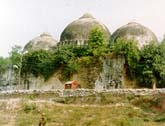|
Hindu nationalism will continue to torment the minorities, but the battle is not lost
Barq girti hai to bechare Musalmanon par'
(Lightning, after all, only strikes the beleaguered Muslims)
-- Mohammad Iqbal
 Several important conclusions, some spilling over to larger questions of minority identity, emerge from the foregoing. The reactions
triggered off by the Muslim Convention and the Majlis-i Mushawarat
illustrate how the democratic process itself imposed constraints
on the articulation of minority grievances and their redressal
through formal procedures.
Several important conclusions, some spilling over to larger questions of minority identity, emerge from the foregoing. The reactions
triggered off by the Muslim Convention and the Majlis-i Mushawarat
illustrate how the democratic process itself imposed constraints
on the articulation of minority grievances and their redressal
through formal procedures.
Most political activists across the
board saw a divide between minority and majority interest, although
this divide rested on an undifferentiated view of what constituted
a 'majority' or a 'minority'. This made it increasingly difficult
after Nehru's death in 1964 to channel the very different aspirations
of minority segments through secular formations.
The left-wing and democratic forces tried to do so in their limited spheres
of influence, countering overt manifestations of Hindu communalism
and providing the healing touch in riot-affected areas. But there
were to tread warily and not identify themselves too closely with
minority causes.
The formal and informal channels of articulation created by Nehru
had collapsed by the 1970s, and the resulting vacuum was filled
by Muslim organisations in UP, Bihar, Andhra Pradesh, Tamil Nadu
and Kerala. They had survived on the fringes of Indian politics,
but were back in business after Nehru's death. Their agenda was
two-fold: To create a distinct Muslim constituency by dwelling
on the Congress failure to assuage their fears and fulfill electoral
promises, and to organise and deepen anti-Congress sentiments,
in co-operation with regional and local parties.
Thus, the Muslim Convention, Majlis-i Mushawarat, Ittehadul-Muslimeen and the Muslim
League in Tamil Nadu and Kerala raised important issues, but theirconstituency and their overall reach were limited. They picked
up a few seats not through a consolidation of 'Muslim votes' but
through a coalition with local or regional forces. In a more general
sense they knew that it did not pay to act solely as Muslim parties.
What does one make of 'Muslim identity', an expression widely
in vogue but without any clear intellectual underpinnings? It
is doubtless true that economic discontent, coupled with escalating
violence, lent weight to notions of identity and acted as a catalyst
to communitarian strategies. Yet Muslim scholars and activists
had recourse to a definition that rested uneasily on the Islamic
concept of a unified millat, and which will always be problematic.
So too is its projection in the political arena. To identity and
locate a set of unified communitarian interests in a mixed and diverse
population is politically inexpedient and empirically hard to sustain.
Hence, the importance of drawing a sharp distinction between political
polemics and the actual realities on the ground.
If so, what does one make of the self-image of a minority, religious
or otherwise? In a nutshell, the language and vocabulary of communitarian
politics, such as those used by the Muslim League or the Majlis-i-Mushawarat,
need decoding because the dominant priest-politicians combination
has, for its own reasons, projected a certain image of itself
and the community it purports to represent.
Thus an outraged Shahabuddin
mistakenly assumed that his defeat in the Rajya Sabha biennial
election in 1984 'sent shock waves in the Muslim community all
over the country.' 'Every Muslim Indian who is politically conscious',
he added, 'is bound to draw certain conclusions from this episode
and he will not be wrong if he thinks that if the national parties
which swear and he will not be wrong if he thinks that if the
national parties which swear by secularism reject Shahabuddins,
Muslim India must find a new strategy.' Wahiduddin Khan rightly
regards such reactions as symptomatic of the 'erroneous self-definition
vis a vis the present.
Finally, we have kept track of the relentless defence of the Muslim
Personal Law and the clear and outward signs of conservative and
orthodox reactions to modern education, composite and syncretic
trends and reformists initiatives.
The Jamiyat al-ulama and the
Jamaat-i Islami regard modernism as the most dangerous heresy
of the day. They have taken the position -- indefensible in a liberal
dialogue -- that changes in Muslim Personal Law are tantamount
to an infringement of the 'covenant' of composite nationalism
which binds Muslims to India and its Hindu nationals.
The intervention
of other organisations has deepened support for this viewpoint.
Theologians, jurists and public figures gathered in Delhi in April
1989, under the aegis of the Institute of Objective Studies, to
explore solutions to contemporary problems in the light of and
in conformity with the principles of the Shariat. Maulana Syed
Abudl Hasan Ali Nadwi and Maulana Minnatullah Rahmani, Amir-i-Shariat
in Bihar and Orissa, were the star performers. The All-India Muslim
Milli Council, founded in Bombay on May 24, 1992, set out to create
collectivity and unity among Muslims on the basis of Kalimah-Tayyabah
[epitome of the Islamic creed] and 'endeavour to see that Muslims
in their role of Khair-i-Umma [welfare of the community] fully
discharge their duties.
These were the loud, clear voices of orthodoxy. Yet there is no
reason to conclude that the Jamaat, the Jamiyat or the All-India
Milli Council represent some form of a Muslim consensus. At the
other end of the ideological spectrum, sections of the Muslim intelligentsia,
both before and after Independence, attributed different meanings
to the 'covenant' with Indian nationalism, and reviewed their
past from secular perspectives.
They affirmed their faith in a
democratic and secular polity, and fashioned their future in relation
to the broad nationwide currents of socio-economic transformations.
They rejected the world-view of the Jamaat and the Jamiyat on
ideological grounds, since they understood the consequences of
community-based politics. They were not numerous, and their views
were sharply contested during the excitement of the Pakistan movement.
But their position was vindicated after Partition when India
emerged out of the communal cauldron to set its house in order
through a democratic and secular regime.
 The Babri Masjid-Ram Janamabhoomi controversy, followed by the demolition
of the mosque, provided yet another historic opportunity to reiterate
secular positions, oppose the mixing of religion with politics,
and revive long-forgotten internal discussions on the efficacy
of reforms and innovation, intellectual regeneration, and developing
a secular temper. The nature and outcome of such dialogues, examined
in the next chapter, will determine the direction of change and
progress among Muslims.
The Babri Masjid-Ram Janamabhoomi controversy, followed by the demolition
of the mosque, provided yet another historic opportunity to reiterate
secular positions, oppose the mixing of religion with politics,
and revive long-forgotten internal discussions on the efficacy
of reforms and innovation, intellectual regeneration, and developing
a secular temper. The nature and outcome of such dialogues, examined
in the next chapter, will determine the direction of change and
progress among Muslims.
The ebb and flow of Hindu nationalism will remain a vital factor
in Indian politics. It will continue to tease and torment religious
minorities, but the battle is not lost. The secular ground has
been narrowed, but it has not disappeared. The critical issue for
religious minorities is whether they are adequately equipped and
motivated to occupy this territory along with other democratic
and secular tendencies. The turf is sticky, but surely negotiable.
Excerpted from Legacy of a Divided Nation, by Mushirul Hasan, 1997, Rs 495, with the publisher's permission.
|

